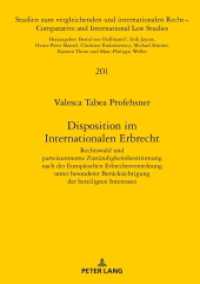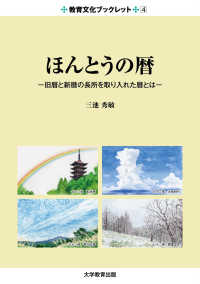- ホーム
- > 洋書
- > ドイツ書
- > Humanities, Arts & Music
- > Arts
- > architecture
Full Description
Aga Khan Award for Architecture 2022 - Inclusive Architecture
The release of the Aga Khan Award for Architecture every three years is an enormously important moment for the architecture world. The projects recognized by this Award represent the vanguard of thinking and practice in architecture that goes beyond the regular scope of building, planning and preservation through its strong impact on the needs and aspirations of societies. This publication presents the twenty shortlisted projects, including the six recipients of the 2020-22 cycle of the Award.
The Aga Khan Award for Architecture's mandate is different from that of many other architecture prizes: it not only rewards architects but also identifies municipalities, builders, clients, artisans and engineers who have played essential roles in the realization of a project. This publication thus presents the projects from various viewpoints alongside detailed and up-to-date images and descriptions.
The acclaimed, interdisciplinary master jury and steering committee of this cycle of the Aga Khan Award for Architecture that determines the projects presented include David Chipperfield, Francis Kéré, Anna Lacaton, Marina Tabassum, and Sarah M. Whiting, to name but a few. Scholarly essays across various disciplines from members of the master jury and steering committee round out the publication. Contributions include a text on the optimism of humanity by Souleymane Bachir Diagne, director of the Institute of African Studies, Columbia University, and a contextualization of Modern Architecture in the Muslim World by Sibel Bozdoğan of Boston University. Kazi Khaleed Ashraf, director-general of the Bengal Institute for Architecture, Landscapes and Settlements, in Dhaka, Bangladesh, writes on the perspective of the dialogical, while Nasser Rabbat, the Aga Khan Professor at MIT, shares notes on architecture as a humanist empire. The texts also include a Salon des Refusés by Nader Teherani, founding principal of Boston-based architecture firm NADAAA.
The texts, which come from a wide range of geographies, are informative and descriptive, often striking an emotional note. Together with the project presentations, the publication thereby guides the reader through a contemplation of an architectural question of increasing urgency in our current times of crisis: how to build ethically for our shared global future.
With contributions by Kazi Khaleed Ashraf, Sibel Bozdoğan, Souleymane Bachir Diagne, Farrokh Derakhshani, Nasser Rabbat, Nader Teherani, and Sarah M. Whiting.
Contents
All 20 shortlisted projects are covered in the book.Bahrain
Rehabilitation of Manama Post Office, Manama, Bahrain, by Studio Anne Holtrop: Built in 1937, the Post Office was rehabilitated to its original form and role as a functioning post office, and added a new wing to the existing building.
Bangladesh
Community Spaces in Rohingya Refugee Response, Teknaf, Bangladesh, by Rizvi Hassan, Khwaja Fatmi, Saad Ben Mostafa: Sustainably built structures in the world's largest refugee camps, which occurred collaboratively in the field without drawings or models.
Urban River Spaces, Jhenaidah, Bangladesh, by Co.Creation.Architects / Khondaker Hasibul Kabir, Suhailey Farzana: A community-driven project providing public spaces in a riverine city with 250,000 residents, offering walkways, gardens and cultural facilities, as well as environmental efforts to increase biodiversity along the river.
Cape Verde
Outros Bairros Rehabilitation Programme, Mindelo, Cape Verde, by OUTROS BAIRROS / Nuno Flores: An urban rehabilitation and redesign of a public space allowed residents to execute works in their own neighbourhoods and enhance their sense of belonging.
India
Lilavati Lalbhai Library at CEPT University, in Ahmedabad, India, by RMA architects / Rahul Mehrotra: The library, a living case study of passive climate mitigation strategies, integrates seamlessly into the existing campus while forging its own distinct identity.
Indonesia
Blimbingsari Airport, Banyuwangi, Indonesia, by andramatin: Serving more than 1,100 domestic passengers per day, the airport's roofs indicate a clear division between departure and arrival halls.
Expandable House, Batam, Indonesia, by ETH Zurich / Stephen Cairns with Miya Irawati, Azwan Aziz, Dioguna Putra and Sumiadi Rahman: This new sustainable dwelling prototype is designed to be flexibly configured around its residents' (often) precarious resources over time.
Iran
Aban House, Isfahan, Iran, by USE Studio / Mohammad Arab, Mina Moeineddini: On a narrow rectangular site in Isfahan's historic centre, the three-storey house is arranged around three open courtyards.
Argo Contemporary Art Museum & Cultural Centre, Tehran, Iran, by ASA North / Ahmadreza Schricker: Distinct materials differentiate new additions from the brick-built historic fabric in this contemporary art museum housed in an abandoned 100-year-old brewery.
Jadgal Elementary School, Seyyed Bar, Iran, by DAAZ Office / Arash Aliabadi: An elementary school, managed by villagers and teachers and funded by tourism and needlework from local women, is a sustainable development centre for surrounding areas.
Lebanon
Renovation of Niemeyer Guest House, Tripoli, Lebanon, by East Architecture Studio: Designed by Oscar Niemeyer but abandoned when civil war erupted in 1975, the guest house has been transformed into a design platform and production facility for the local wood industry.
Kuwait
Wafra Wind Tower, Kuwait City, Kuwait, by AGi Architects: The 13-storey building conceived as a wind tower features a central, vertical courtyard that provides natural ventilation to each apartment unit.
Morocco
Issy Valley Improvement, Ait Mansour, Morocco, by Salima Naji: While improving the palm orchards and water reservoirs, trails and facilities for tourists were also upgraded in the first phase of a larger project for the valley.
Niger
Niamey 2000, Niamey, Niger, by united4design / Yasaman Esmaili, Elizabeth Golden, Mariam Kamara, Philip Straeter: As a response to a housing shortage amid rapid urban expansion, this prototype housing of six family units seeks to increase density while remaining culturally appropriate.
Palestine
Tulkarm Courthouse, Tulkarm, Palestine, by AAU Anastas: Featuring two buildings, one for administration and the other containing 10 courtrooms, the Courthouse is anchored to its urban context by a public space.
Senegal
CEM Kamanar Secondary School, Thionck Essyl, Senegal, by Dawoffice / David Garcia, Aina Tugores: For this secondary school, volunteers, using local techniques, produced vault modules from clay which (with lattices) act as evaporating coolers.
Sri Lanka
Lanka Learning Centre, Parangiyamadu, Sri Lanka, by feat.collective / Noemi Thiele, Felix Lupatsch, Valentin Ott and Felix Yaparsidi: A multifunctional cultural centre and adult school where locals learn craftsmanship creates a multi-ethnic meeting point.
Tunisia
Le Jardin d'Afrique, Zarzis, Tunisia, by Rachid Koraïchi: An ecumenical cemetery provides a sanctuary and dignified place of final repose for the hundreds of unburied bodies that had been washing ashore.
Turkey
Rehabilitation of Tarsus Old Ginnery, Tarsus, Turkey, by Sayka Construction Architecture Engineering Consultancy: Adaptive reuse of an abandoned 19th century ginnery allows the operation of a contemporary centre for archaeological research and public engagement.
United Arab Emirates
Flying Saucer Rehabilitation, Sharjah, United Arab Emirates, by SpaceContinuum Design Studio / Mona El Mousfy: The Flying Saucer, a 1978 Brutalist-style building that was fully restored as a community art space, contributes to Sharjah's collective cultural memory.








